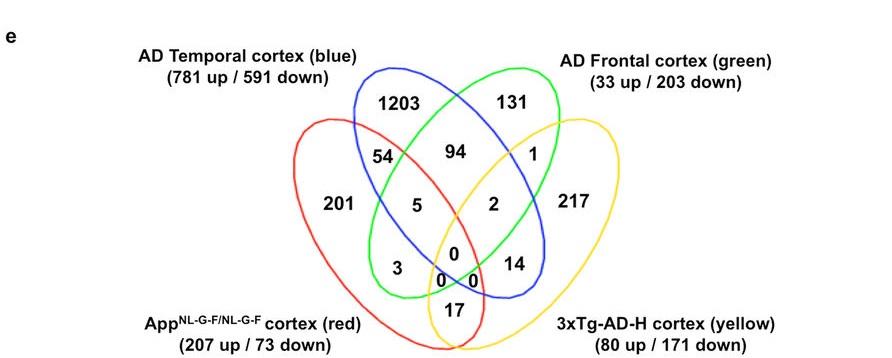神経変性疾患:アルツハイマー病患者とマウスモデルの皮質における遺伝子発現の比較プロファイリングから明らかになったアミロイドーシスと神経炎症のつながり
Comparative profiling of cortical gene expression in Alzheimer’s disease patients and mouse models demonstrates a link between amyloidosis and neuroinflammation
2017年12月19日 Scientific Reports 7 : 17762 doi: 10.1038/s41598-017-17999-3

アルツハイマー病(AD)は最も多いタイプの認知症であり、アミロイドβ(Aβ)と神経原線維変化の蓄積を特徴とする。酸化ストレスと炎症は、ADの発症と進行に重要な役割を担っていると考えられている。しかし、これらの現象がどの程度、Aβ病変に関わっているのか、まだわかっていない。我々は、AD患者の脳とAppNL-G-F/NL-G-Fおよび3xTg-AD-Hマウスモデルで、種間での遺伝子発現の比較を行った。AppNL-G-F/NL-G-FとヒトADの皮質で共通した遺伝子変化は、炎症応答や免疫疾患との相関が見られた。それらの中で、AD関連遺伝子(C4a/C4b、Cd74、Ctss、Gfap、Nfe2l2、Phyhd1、S100b、Tf、Tgr2、Vim)の発現は、グリオーシスの悪化をともなってAβアミロイドーシスが進行したときにAppNL-G-F/NL-G-Fの皮質で上昇し、一方で3xTg-AD-HとヒトADの皮質で共通して変化した遺伝子は、神経疾患との相関があった。またAppNL-G-F/NL-G-Fの皮質では、ゲノムワイド関連解析でADのリスク因子とされた遺伝子や、遅発性ADにおける遺伝学的ノードとして同定された遺伝子(Abi3、Apoe、Bin2、Cd33、Ctsc、Dock2、Fcer1g、Frmd6、Hck、Inpp5D、Ly86、Plcg2、Trem2、Tyrobp)の発現も変化していた。これらの結果は、皮質Aβアミロイドーシスと神経炎症応答の間の強い相関を示唆し、性差が及ぼすAD発症への影響についての理解を深めるものである。
Corresponding Author
Alzheimer’s disease (AD) is the most common form of dementia, characterized by accumulation of amyloid β (Aβ) and neurofibrillary tangles. Oxidative stress and inflammation are considered to play an important role in the development and progression of AD. However, the extent to which these events contribute to the Aβ pathologies remains unclear. We performed inter-species comparative gene expression profiling between AD patient brains and the AppNL-G-F/NL-G-F and 3xTg-AD-H mouse models. Genes commonly altered in AppNL-G-F/NL-G-F and human AD cortices correlated with the inflammatory response or immunological disease. Among them, expression of AD-related genes (C4a/C4b, Cd74, Ctss, Gfap, Nfe2l2, Phyhd1, S100b, Tf, Tgfbr2, and Vim) was increased in the AppNL-G-F/NL-G-F cortex as Aβ amyloidosis progressed with exacerbated gliosis, while genes commonly altered in the 3xTg-AD-H and human AD cortices correlated with neurological disease. The AppNL-G-F/NL-G-F cortex also had altered expression of genes (Abi3, Apoe, Bin2, Cd33, Ctsc, Dock2, Fcer1g, Frmd6, Hck, Inpp5D, Ly86, Plcg2, Trem2, Tyrobp) defined as risk factors for AD by genome-wide association study or identified as genetic nodes in late-onset AD. These results suggest a strong correlation between cortical Aβ amyloidosis and the neuroinflammatory response and provide a better understanding of the involvement of gender effects in the development of AD.

